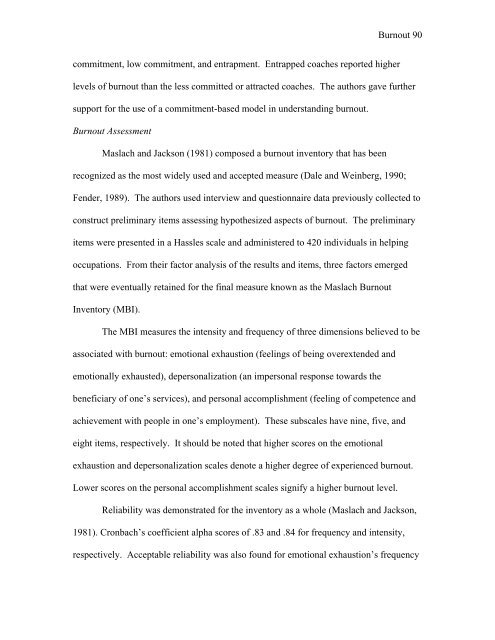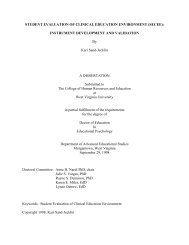Coach and Athlete Burnout - West Virginia University
Coach and Athlete Burnout - West Virginia University
Coach and Athlete Burnout - West Virginia University
You also want an ePaper? Increase the reach of your titles
YUMPU automatically turns print PDFs into web optimized ePapers that Google loves.
commitment, low commitment, <strong>and</strong> entrapment. Entrapped coaches reported higher<br />
<strong>Burnout</strong> 90<br />
levels of burnout than the less committed or attracted coaches. The authors gave further<br />
support for the use of a commitment-based model in underst<strong>and</strong>ing burnout.<br />
<strong>Burnout</strong> Assessment<br />
Maslach <strong>and</strong> Jackson (1981) composed a burnout inventory that has been<br />
recognized as the most widely used <strong>and</strong> accepted measure (Dale <strong>and</strong> Weinberg, 1990;<br />
Fender, 1989). The authors used interview <strong>and</strong> questionnaire data previously collected to<br />
construct preliminary items assessing hypothesized aspects of burnout. The preliminary<br />
items were presented in a Hassles scale <strong>and</strong> administered to 420 individuals in helping<br />
occupations. From their factor analysis of the results <strong>and</strong> items, three factors emerged<br />
that were eventually retained for the final measure known as the Maslach <strong>Burnout</strong><br />
Inventory (MBI).<br />
The MBI measures the intensity <strong>and</strong> frequency of three dimensions believed to be<br />
associated with burnout: emotional exhaustion (feelings of being overextended <strong>and</strong><br />
emotionally exhausted), depersonalization (an impersonal response towards the<br />
beneficiary of one’s services), <strong>and</strong> personal accomplishment (feeling of competence <strong>and</strong><br />
achievement with people in one’s employment). These subscales have nine, five, <strong>and</strong><br />
eight items, respectively. It should be noted that higher scores on the emotional<br />
exhaustion <strong>and</strong> depersonalization scales denote a higher degree of experienced burnout.<br />
Lower scores on the personal accomplishment scales signify a higher burnout level.<br />
Reliability was demonstrated for the inventory as a whole (Maslach <strong>and</strong> Jackson,<br />
1981). Cronbach’s coefficient alpha scores of .83 <strong>and</strong> .84 for frequency <strong>and</strong> intensity,<br />
respectively. Acceptable reliability was also found for emotional exhaustion’s frequency












